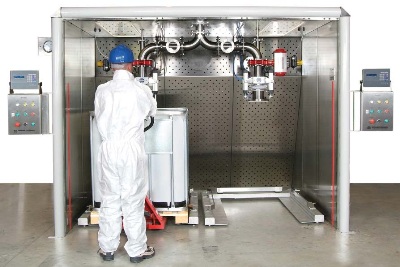Hosokawa Containment along with a multinational biotech production company has developed a bespoke contained waste handling system to limit operator intervention and maintain minimal operator exposure levels to possible hazardous airborne contamination. The waste containment and collection system is designed to prevent the airborne contaminants from being released when the waste collection process takes place.
Operation
The system ensures that the liquid waste is pumped to a dual outlet fitted inside a laminar air flow booth, wherein each outlet is connected via a sequence of safety interlocks to an empty IBC (Intermediate Bulk Containment).
The IBC is manually placed on a weigh scale and connected by an airtight seal. A predetermined amount of waste is pumped into the IBC and the weighing scales act as a safety back up to switch off the flow and prevent overfill. Safety sensors ensure that the flow of waste is prevented when there is no unfilled IBC.
In order to prevent airborne contamination, air is displaced from the IBC and collected by an extraction system before it is passed via the HEPA(High-Efficiency Particulate Arresting) filter.
After the flow of waste is stopped and the IBC is filled, a cleaning process is activated, wherein spray balls wash the chute and an outlet valve with water to make sure that the top part of the IBC does not have any waste product contaminates after the seal is removed. Then the seal on the outlet of the IBC is broken by the operator to install the sealing cap. To further ensure operator’s safety with regard to airborne contamination at this stage, air within the area of operation is extracted by a localized extraction system.

Safety
The Hosokawa Containment system is designed such that it allows only one IBC to be filled each time.
Causing no delay whatsoever, the next container is filled immediately after the first one is filled and sealed. The Hosokawa waste collection and containment system has passed stringent Factory Acceptance Tests before an audience of project engineers, biological experts from the Health and Safety Executive and customers.
.jpg)
This information has been sourced, reviewed and adapted from materials provided by Hosokawa Micron.
For more information on this source, please visit Hosokawa Micron.